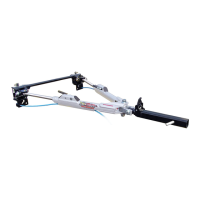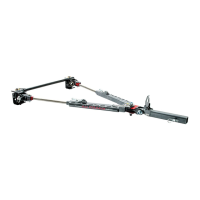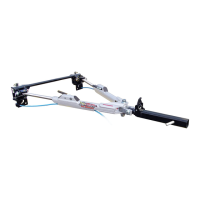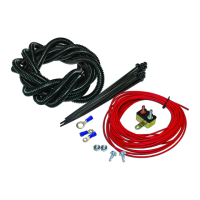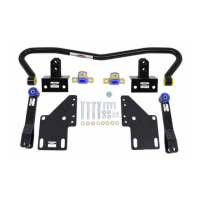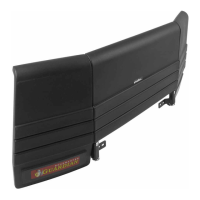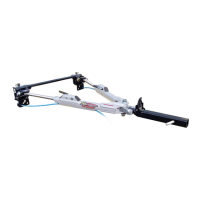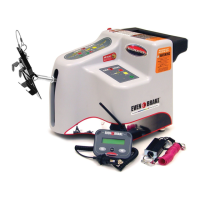1
To ensure your safety and that of your passengers, as
well as the safety of others on the road, follow these safe
towing practices at all times.
CAUTION
Do not back up the motorhome with the towed ve-
hicle attached.
Backing up with the towed vehicle attached will
cause the towed vehicle to “jackknife,” which will dam-
age the tow bar, the baseplate, the receiver hitch, the
towed vehicle's front end, and/or the rear of the mo-
torhome. Backing up with the towed vehicle attached
is the primary cause of tow bar damage and will void
the warranty.
• Be sure the vehicle can be towed before taking it on
the road. Some vehicles must be equipped with a transmis-
sion lube pump, an axle disconnect, driveline disconnect
or free-wheeling hubs before they can be towed. Failure
to properly equip the vehicle will cause severe damage
to the transmission.
Check the vehicle manufacturer’s instructions for the
proper procedure(s) to prepare the vehicle for towing.
• The tow bar must be approximately level with the
ball hitch on the motorhome. Towing with the tow bar at
an upward or downward slope puts undue strain on the tow
bar baseplate and the ball mount. Driving over sharp in-
clines or declines could force the coupler off the hitch ball.
If it is necessary to raise or lower the hitch, two op-
tional accessories are available: an adjustable ball hitch,
part number 880; and roller hitch drops, in 4" through 10"
drops (part numbers 051-4 through 051-10).
• The steering wheel must be unlocked and free to
turn when towing. Failure to do so can cause severe
tire and equipment damage. Check the manufacturer’s
instructions for the proper towing procedure(s).
• Always use safety cables when towing. The safety
cables must connect the towed vehicle to the towing ve-
SAFE TOWING PRACTICES
Figure 1
Figure 2
INSTALLER'S SAFETY CHECKLIST
• Read the instructions thoroughly before installing
the ‘quick-disconnect’ (‘QD’) system and its compo-
nents. If the towed vehicle baseplate has a removable
front arm, the tow bar will be attached to the QD system.
If the QD system is not properly aligned, centered and
positioned on the towed vehicle, the tow bar will not be
centered on the towed vehicle, which may cause excessive
tire wear and other consequential, non-warranty damage.
• Show the owner how to properly operate the tow
bar. Familiarize yourself with the features of the tow bar.
Demonstrate them to the owner, and ask the owner to
connect and disconnect the tow bar and other components
of the towing system, until the owner is comfortable with
its operation.
• The tow bar must be attached to a baseplate which
is bolted to the towed vehicle’s frame or unibody. In
order to be towed, virtually all vehicles require a tow bar
baseplate that is connected to the frame, unibody or chas-
sis and extends beyond the bumper.
• The installer must NOT use the tow bar as a ground
for welding. Connecting a ground to the ‘A-frame’ of the
tow bar will cause current to flow through the locking
spring, which will detemper the spring and destroy the
locking mechanism.
• Under no circumstances should the tow bar be
welded to the vehicle, nor should any of the pre-punched
mounting holes be altered. Any welding or altering of the
tow bar will void the owner’s warranty.
Failure to follow these instructions may cause prop-
erty damage, personal injury or even death.
hicle, frame to frame.
Additionally, check to ensure that the safety cables are
the proper length. Refer to the sections titled “How to use
safety cables” and “Proper installation of safety cables”
for further information.
The weight capacity of the safety cables must meet
or exceed the towed weight, or the safety cables will
fail.
• Inspect the system before towing — check the
mounts, brackets, bolts, fasteners, wiring, the safety ca-
bles and all other sys-
tem components each
time before towing.
Check the coupler ball
clamp and ball socket
(Figure 1) for fractures
or cracks in the steel.
If any component
is damaged, replace
it before towing.
Check the nut at the bottom of the threaded hitch ball
shank (Figure 2) to en-
sure that it is tightened
to the manufacturer’s
torque specifications.
Inspect the nut and the
bottom of the threaded
hitch ball shank (Fig-
ure 2) for signs of
wear caused when
the motorhome ‘bot-
toms out.’ If the nut is
damaged, replace it; if the threaded shank is damaged,
replace the hitch ball and shank.
Additionally, check the tow bar baseplate every 3,000
miles — inspect for any fractures or cracks in the steel,
or any visible damage. Do not tow if the tow bar base-
continued on next page
